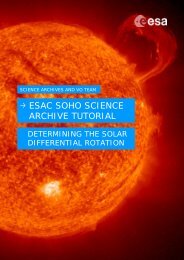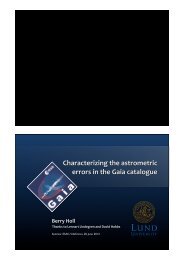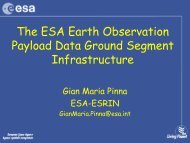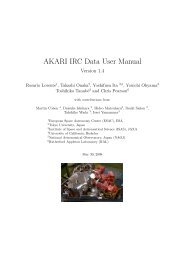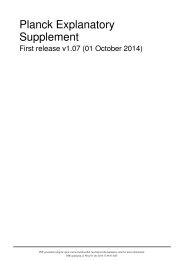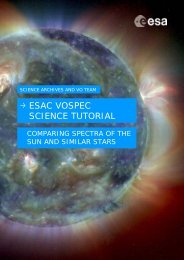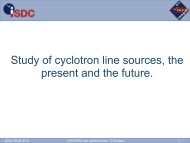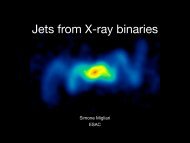1 Announcement of Opportunity AKARI (ASTRO-F) CALL FOR ... - ESA
1 Announcement of Opportunity AKARI (ASTRO-F) CALL FOR ... - ESA
1 Announcement of Opportunity AKARI (ASTRO-F) CALL FOR ... - ESA
- No tags were found...
Create successful ePaper yourself
Turn your PDF publications into a flip-book with our unique Google optimized e-Paper software.
EAO-3Atlantic Anomaly (SAA) where a high hit rate <strong>of</strong> ionizing particles are anticipated.Note, however, that targets near the ecliptic plane generally have a small number <strong>of</strong>observation opportunities. Observers should understand that opportunities to observeparticular objects or fields with <strong>AKARI</strong> are severely limited. Observations <strong>of</strong> generictargets distributed over the entire sky are preferred to those <strong>of</strong> specific targets. Timecritical observations are not recommended for the same reasons. Target-<strong>of</strong>-opportunity(TOO) proposals will not be accepted as OT proposals. They can instead be requestedas director’s time. An Open Time proposal should have a sufficient number <strong>of</strong> backuptargets (priority C) in addition to those with A and B priorities. The targets should bedistributed across priorities A:B:C in the ratio <strong>of</strong> 1:1:1.Because <strong>of</strong> the increased number <strong>of</strong> hot pixels, observers should take account <strong>of</strong> this factseriously and are strongly recommended to have sufficient redundancy in theirobservation plan. Particularly deep imaging (IRCZ0) and spectroscopy (IRCZ4) shouldhave at least 3 pointing observations for the same target. Refer to the Observer’smanual for phase 3 (version 1.2) for details <strong>of</strong> the instrument performance.5. Review process and scheduleProposals may be submitted until 6 July 2009. All proposals will first be technicallyassessed by the User Support Team at <strong>ESA</strong>C, who will also prepare summary statisticson the response. The proposals will then be sent to an <strong>ESA</strong> established European TimeAllocation Committee for peer review. <strong>ESA</strong> and ISAS will make the reviewindependently. The following items will be taken into account during the reviewprocess:• Scientific case and justification• Scientific merit and relevance <strong>of</strong> the proposed observation(s)• Exploitation <strong>of</strong> the <strong>AKARI</strong> instrument• Duplication with MP observations and with observations already executed in thecold phase• Technical feasibility and adequate performance estimation• Visibility and requested number <strong>of</strong> pointingsThe final selection <strong>of</strong> the proposals will be made based on the results <strong>of</strong> both reviews. Incase <strong>of</strong> conflict, the proposal with the higher ranking in the individual lists will beselected. If there are similar proposals with similar evaluation in both sides,8



